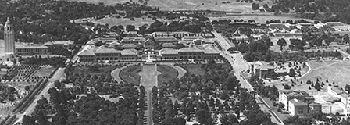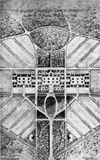INTRODUCTION |
|
|
|
| Stanford's academic reserve is home to many things, some of them icons for the university's identity: laboratory buildings, splendid outdoor sculpture, the Quad, Frost, Hoover Tower, and the Oval. It has also left room for Nature.The Arboretum, the edges of Lagunita, and the "ears" of the Oval -- left in native vegetation in Frederick Law Olmsted's original plan -- provide pleasant places to walk and explore. | |
 detail from 1922 aerial photograph Stanford University Archives |
|
The richness of the bird fauna here owes much to the generous land endowment the Stanfords provided for the university. Surrounding the academic core campus are virtually undeveloped foothills, a vernal lake (Lagunita), the Arboretum, and the riparian habitat of San Francisquito Creek and the Golf Course. Though many of the species present on Jasper Ridge and other more "natural" environments are missing from the academic core of the campus, the diversity of habitats, the history of experimental plantings, and Stanford's active efforts to preserve relatively undisturbed spaces have created opportunity for others. Hence the attractiveness of Stanford to experienced South Bay birders as well as to campus residents. |
|
Of course change is part of life in this habitat, as it is in others. Development has modified the environment in ways that have made it less suitable for some species, more for others. Landscaping the Oval and its surroundings have cut into the numbers of California Quail; disease and selective cutting have made the Eucalyptus Grove less habitable for the Great Horned Owls that used to nest there. In other ways, too, the campus fauna has changed over time. Displacement of the range of species, probably associated with climate change, has increased the abundance of birds that once were known only known south of the Bay Area: the campus list for 1931, for example, does not list the Northern Mockingbird -- now perhaps the most persistent avian voice in the faculty housing area. |
 California Quail  Great Horned Owl  Northern Mockingbird |

detail from c.1950 aerial
photograph
Stanford University Archives
| Early Stanford naturalists took note of the campus birds, and when I first joined the faculty in 1960 I quickly got hold of Birds of the Stanford Campus, a home-grown guide to some of the most obvious resident species. That provided an invitation to do more, and from time to time faculty birders -- Lincoln Moses, Tom Grey, and Mike Wald, to mention a few -- would comment on the need for something more definitive. There were more recent efforts to draw on. Leonard Ratner and his wife Ingeborg have been determined campus walkers and naturalists, and she recently published a delightful book on Nature Walks at Stanford with her own illustrations of birds and trees. A serious course on the Biology of Birds appeared in the mid-1980s, taught by Paul Ehrlich; Paul had co-authored the very popular Birder's Handbook and its format suggested a way in which a modern Stanford guide could be put together. Simon and Schuster, the Handbook's publisher, kindly gave us permission to use its pages. Darryl Wheye, Paul's collaborator on three books -- including the Birder's Handbook -- drew 125 bird portraits and designed and produced the web-site. A group of us including the above-mentioned faculty members and Dr. Steve Rottenborn, a Stanford Ph.D. and ace birder who had taught with Paul, acted as the Admissions Committee to decide which species should be included. This group is now in the process of accumulating Stanford Notes for each entry -- a process in which we hope you will participate as this web-site goes interactive. |
| We hope this effort may encourage a few students, faculty, staff, alumni and community neighbors to take up a fascinating activity, and that it will help satisfy the curiosity of campus walkers who have seen an unfamiliar bird or an unusual instance of bird behavior. Most of all, we hope that it will add another dimension to the appreciation of a campus that is remarkable not only for architecture and outdoor sculpture, but for the large slice of Nature that it wisely continues to conserve. | |
BACK |
|
|





